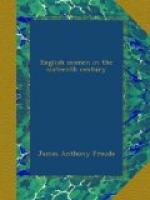He divided his men and attacked both together.
One party he led in person. The cannon opened
on him, and an Englishman next to him was killed.
He dashed on, leaving the Spaniards no time to reload,
carried the gate at a rush, and cut his way through
the streets to the great square. The second division
had been equally successful, and St. Domingo was theirs
except the castle, which was still untaken. Carlile’s
numbers were too small to occupy a large city.
He threw up barricades and fortified himself in the
square for the night. Drake brought the fleet
in at daybreak, and landed guns, when the castle surrendered.
A messenger—a negro boy—was sent
to the Governor to learn the terms which he was prepared
to offer to save the city from pillage. The Spanish
officers were smarting with the disgrace. One
of them struck the lad through the body with a lance.
He ran back bleeding to the English lines and died
at Drake’s feet. Sir Francis was a dangerous
man to provoke. Such doings had to be promptly
stopped. In the part of the town which he occupied
was a monastery with a number of friars in it.
The religious orders, he well knew, were the chief
instigators of the policy which was maddening the
world. He sent two of these friars with the provost-marshal
to the spot where the boy had been struck, promptly
hanged them, and then despatched another to tell the
Governor that he would hang two more every day at
the same place till the officer was punished.
The Spaniards had long learnt to call Drake the Draque,
the serpent, the devil. They feared that the
devil might be a man of his word. The offender
was surrendered. It was not enough. Drake
insisted that they should do justice on him themselves.
The Governor found it prudent to comply, and the too
hasty officer was executed.
The next point was the ransom of the city. The
Spaniards still hesitating, 200 men were told off
each morning to burn, while the rest searched the
private houses, and palaces, and magazines. Government
House was the grandest building in the New World.
It was approached by broad flights of marble stairs.
Great doors opened on a spacious gallery leading into
a great hall, and above the portico hung the arms of
Spain—a globe representing the world, a
horse leaping upon it, and in the horse’s mouth
a scroll with the haughty motto, ‘Non sufficit
orbis.’ Palace and scutcheon were levelled
into dust by axe and gunpowder, and each day for a
month the destruction went on, Drake’s demands
steadily growing and the unhappy Governor vainly pleading
impossibility.
Vandalism, atrocity unheard of among civilised nations,
dishonour to the Protestant cause, Drake deserving
to swing at his own yardarm; so indignant Liberalism
shrieked, and has not ceased shrieking. Let it
be remembered that for fifteen years the Spaniards
had been burning English seamen whenever they could
catch them, plotting to kill the Queen and reduce
England itself into vassaldom to the Pope. The
English nation, the loyal part of it, were replying
to the wild pretension by the hands of their own admiral.
If Philip chose to countenance assassins, if the Holy
Office chose to burn English sailors as heretics, those
heretics had a right to make Spain understand that
such a game was dangerous, that, as Santa Cruz had
said, they had teeth and could use them.




